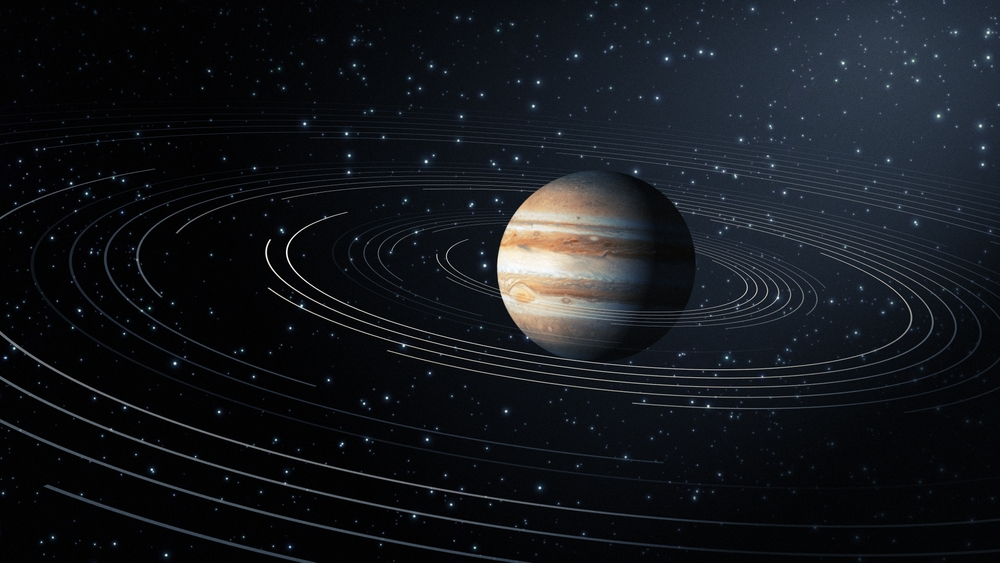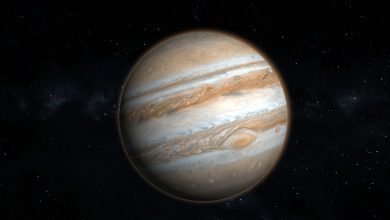Journey to the Giant: 5 Incredible Facts About Jupiter

Jupiter, the fifth planet from the Sun, stands as a colossal giant dominating our solar system. With a diameter 11 times that of Earth and a mass that exceeds the combined mass of all other planets, Jupiter’s sheer size and influence are nothing short of majestic.
Studying Jupiter is crucial as it holds numerous secrets about the early solar system and the formation processes of planetary bodies. Its unique characteristics, from the turbulent Great Red Spot to its multitude of moons and powerful magnetic field, make it an object of intrigue and importance for astronomers and scientists alike.
In this blog, we’ll delve into five incredible facts that highlight Jupiter’s fascinating aspects. We’ll explore its enormous size, the mysterious Great Red Spot, its faint yet intriguing ring system, the multitude of moons it hosts, and its intense magnetic field. Each fact offers a glimpse into why Jupiter continues to captivate the minds of those who seek to unravel the mysteries of our cosmic neighbourhood.
Fact 1: The Largest Planet in the Solar System
Standing as the behemoth of our celestial neighborhood, Jupiter’s immense size and mass distinguish it as the largest planet in the solar system. Boasting a diameter of approximately 86,881 miles (139,820 kilometers), Jupiter dwarfs Earth, which has a diameter of only about 7,918 miles (12,742 kilometers).
Furthermore, Jupiter’s mass is an astounding 318 times that of Earth and is greater than the combined mass of all the other planets in our solar system. This massive scale significantly influences the gravitational dynamics within the solar system, playing a pivotal role in shaping the orbits of surrounding celestial bodies.
Compared to the other gas giants, Saturn, Uranus, and Neptune, Jupiter still holds the title of the largest and most massive, underscoring its dominance as the king of planets.
Fact 2: The Great Red Spot
The Great Red Spot on Jupiter is one of the most iconic and enduring features in our solar system. This colossal storm, larger than Earth itself, has been raging for at least 400 years. The Great Red Spot is an anticyclonic storm, meaning it rotates counterclockwise, and it is situated in Jupiter’s southern hemisphere.
Historical observations date back to the 17th century, with astronomers such as Giovanni Cassini and Robert Hooke documenting the storm’s presence. Over time, the Great Red Spot has exhibited significant changes in size and color. Once spanning over 25,000 miles in diameter, it has gradually shrunk to approximately half that size today.
The storm’s distinct reddish hue, attributed to complex chemical reactions in Jupiter’s atmosphere, also varies, sometimes appearing more intense and at other times fading to a paler shade. These fluctuations highlight the dynamic and ever-changing nature of this extraordinary Jovian storm.
Fact 3: A Ring System
While Saturn’s majestic rings often steal the spotlight, Jupiter’s faint ring system is a fascinating feature in its own right. Discovered in 1979 by the Voyager 1 spacecraft, Jupiter’s rings are composed primarily of dust particles ejected by its moons during impacts from meteoroids.
Unlike the bright, icy rings of Saturn, which are easily visible from Earth, Jupiter’s rings are much darker and thinner, making them difficult to observe without the aid of advanced telescopes or space probes. These rings consist of three main segments: the halo ring, the main ring, and the gossamer rings.
The halo ring is a thick, toroidal section closest to Jupiter, followed by the relatively narrow main ring, and the faint gossamer rings that extend outward, named after the moons Amalthea and Thebe. Although less visually striking than Saturn’s rings, Jupiter’s ring system offers unique insights into the planet’s environmental processes and the interactions between its moons and surrounding space debris.
Fact 4: Numerous Moons
Jupiter’s entourage of moons is as fascinating as the planet itself, with over 79 known natural satellites. Among these, the Galilean moons stand out prominently due to their significant sizes and unique characteristics. Discovered by Galileo Galilei in 1610, these four moons—Io, Europa, Ganymede, and Callisto—remain some of the most studied and intriguing celestial objects.
Ganymede, in particular, distinguishes itself as the largest moon in the solar system. With a diameter of about 3,273 miles (5,268 kilometers), Ganymede surpasses even Mercury in size. This enormous satellite boasts a diverse landscape featuring a mix of rocky terrain, icy crust, and potential subsurface ocean, further fueling interest in its geological and potentially habitable conditions.
The Galilean moons offer a miniature solar system in themselves, each providing unique insights into planetary formation and the dynamic processes occurring within Jupiter’s extensive gravitational influence.
Fact 5: An Intense Magnetic Field
Exploration of Jupiter’s powerful magnetic field reveals a force that is both awe-inspiring and profoundly influential. Jupiter’s magnetic field is the strongest of any planet in our solar system, created by the rapid rotation and the metallic hydrogen within its interior. This immense magnetosphere extends millions of miles into space, enveloping many of Jupiter’s moons and creating a region of intense radiation.
The magnetic field not only protects Jupiter but also traps high-energy particles, leading to spectacular auroras at its poles, which are far more powerful than those seen on Earth. The effects of this titanic magnetic field are wide-ranging, influencing the orbits of nearby particles and creating complex interactions with the solar wind.
These interactions have significant implications for understanding the magnetospheres of other planets and the dynamics of space weather. Exploration missions, such as the Juno spacecraft, continue to provide valuable data, uncovering new details about this formidable magnetic environment.
Conclusion
As we wrap up our journey through some of the most fascinating facts about Jupiter, we’re reminded of the sheer scale and complexity of this iconic gas giant. From Jupiter’s monumental size and mass, which dwarf all other planets, to the enduring storms of the Great Red Spot, the planet consistently surprises and captivates us.
We journeyed through its faint ring system, often overshadowed by Saturn’s but no less intriguing, and discovered its multitude of moons, each offering unique insights into planetary science. Finally, we delved into the mysteries of Jupiter’s powerful magnetic field, a force of nature that continues to puzzle and inspire astronomers.
The significance of continued exploration and study of Jupiter cannot be overstated. Each mission to this gas giant, such as the ongoing Juno spacecraft, unravels new layers of understanding about not only Jupiter itself but also the broader workings of our solar system. The more we learn, the more we appreciate the complexity and beauty of these celestial bodies, and the more questions we generate for future generations of explorers and scientists to answer.
Thank you for joining us on this cosmic adventure. If you found this blog enlightening, please feel free to share it with others who might be fascinated by the wonders of our solar system. Don’t forget to engage with our additional content to keep exploring the universe and stay updated with the latest discoveries in space exploration. Together, let’s continue to marvel at the giant that is Jupiter.
We hope you enjoyed reading “Journey to the Giant: 5 Incredible Facts About Jupiter” and discovered something new about our solar system’s largest planet. Now, we’d love to hear from you! Feel free to leave your comments or questions below—your curiosity fuels our next explorations and helps us bring even more exciting content to you.
For those intrigued by the wonders of our universe, don’t miss out on our related content. Explore the hidden secrets of Saturn’s rings, dive into the enigmatic oceans of Europa, or learn about the fascinating atmospheres of our neighboring planets. Stay tuned for future topics as well—upcoming articles will uncover the mysteries of distant exoplanets, the potential for life beyond Earth, and the latest breakthroughs in space technology.
Join us on this ongoing cosmic journey and ensure you never miss an update by subscribing to our newsletter. Together, let’s continue to marvel at the universe and push the boundaries of our knowledge. Thank you for being a part of our space exploration community!



